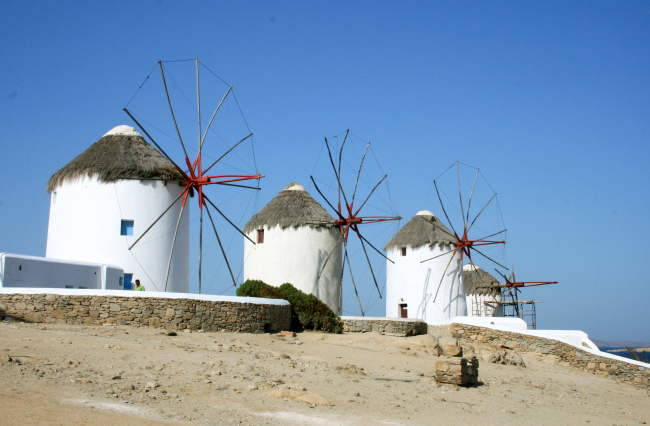SANTORINI, Greece (AP) ― Whitewashed houses stacked like sugar cubes on the cliffs. Colorful sunsets and black-sand beaches. Donkeys, windmills and a local winemaking tradition that goes back to ancient times.
These are some of the things that stood out on a visit to the Cyclades, a Greek island chain in the Aegean Sea.
Little wonder the place draws gaggles of visitors ― enough to make even crowd-loving extroverts long for a peaceful island paradise.
Oh, wait ― that’s why we were there. And that’s why, whenever we could, we avoided busy town centers in favor of lying in the sun with a lazy glass of wine.
First stop was the island of Mykonos. My boyfriend and I arrived by ferry from Athens, then took a bus to the island’s center of activity, the town of Mykonos, also known as Chora. It’s a busy place: long lines, picture-taking galore and overpriced trinkets bulging from store shelves. I was glad we’d opted to stay in another village, Ornos, about 3.2 kilometers away, in a hotel five minutes from the beach and a handful of restaurants. There we soaked up the sun by the sea and by the pool, drank wine and met some British travelers who also treasured the calm and quiet.
 |
The picturesque windmills on the island of Mykonos in the Cyclades, a Greek island chain in the Aegean Sea. (AP-Yonhap) |
Early morning turned out to be a relatively tranquil time to see Chora ― even if the walk there from Ornos meant dodging cars on the sometimes-minuscule shoulder of the road. We spotted a donkey on the way, and in town, with the few other tourists there that early, we admired large windmills on hilltops that are among the island’s most photographed and visited features. Windmill construction on the island dates to the 16th century.
Then it was off to the winding roads of the Little Venice neighborhood to get lost amid the whitewashed buildings with their colorful balconies. Going early also offered a chance to see a bit of local life behind-the-scenes: shopkeepers mopping up concrete slabs outside their storefronts and arranging their merchandise before the busy day began. We also stopped by to see the ancient urns and memorial statues at the Archaeological Museum.
Mykonos is known for its nightlife, and we had every intention of experiencing it at least once. But staying in laidback Ornos with a glass of wine at a restaurant each night proved too appealing.
Next we visited the island of Santorini. Our hotel was in the village of Perissa, known for its black-sand beach but far less crowded than we expected. One morning, we got a cliff-top view of the island after a hike up Mesa Vouno mountain to Ancient Thira, the site of an excavated city dating to the ninth century B.C.
Later on, we decided for once to brave the crowds and visit the town of Oia, known for its dramatic sunsets. The town is located on steep cliffs offering a panoramic view of the Santorini’s caldera, a volcanic crater that’s partly under the sea. We headed to find a good vantage point with thousands of other visitors eager to watch the sun dip down to the horizon. A sliver of rail space at a parking lot was as good as we could get.
But it didn’t matter. The sunset was so glorious, I didn’t mind the crowds.








